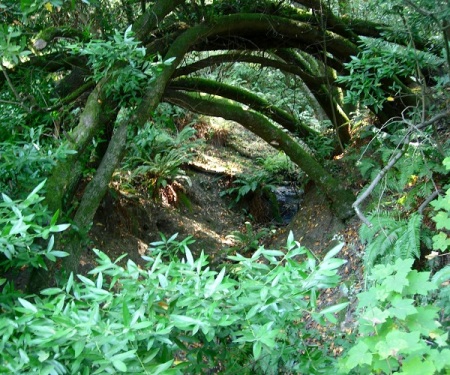Naturally, the people of a city named Oakland cherish their trees.
But trees are living things, and every one must die at some point. After years of drought plus one wet winter, I’ve noticed a lot of downed trees. This one was in Leona Heights, an oak. When oaks topple, that’s the end of them.
This one, a bay laurel, was in Joaquin Miller Park. Fallen bay trees commonly reroot, which is a handy thing in their preferred moist habitat.
Fallen trees may interest field geologists because as their roots rip out, they expose the bedrock in areas with thick vegetation. Thus information from “tree throws” can help in mapping the rocks. For instance, I inspected the rocks uprooted by this tree . . .
. . . and noted that they were typical mudstone of the Joaquin Miller Formation. The park is the formation’s type area, after all.

Another treefall farther downstream exposed serpentinite. (The two very different rock types are separated by the Chabot fault.)
Sometimes data points like these are the only way to get a handle on steep, vegetated terrain.
Research-type geologists consider “tree throw” a significant actor in the evolution of wooded landscapes (here’s a taste from a recent conference).
Down by the water, especially along the smaller creeks, fallen bay laurels often span the stream and root on both sides. Sometimes it’s charming, like here above Dunsmuir House, but it’s usually a hassle if you’re trying to walk along the streambed.
To hydrologists — geologists who specialize in streams — fallen trees are a crucial part of stream systems. Natural streams always contain some amount of dead wood, because it lasts for years before it rots away or burns up.
Wood doesn’t act like sand and gravel. It doesn’t wash away easily, it sticks around and snags stuff. So making a realistic model of stream behavior requires a sophisticated understanding of how this “wood load” affects the water. Hydrology journals publish a steady trickle of papers on this topic.
Most of us would rather that trees stayed standing and streambeds stayed clear. That only happens in landscaped parks. To know nature, you have to learn to appreciate snags.







31 May 2016 at 3:12 pm
Hi Andrew–a fun post as always. Actually most of the authors and audience for this type of article are ecologists–J-NABS is the journal for study of benthos, i.e. the biota that live on or in the woody debris and all the stuff that gets “snagged” by it. All too many hydrologists are only concerned with the large scale movement of the streamflow rather than the little small scale variations that create a diversity of niches for different critters.